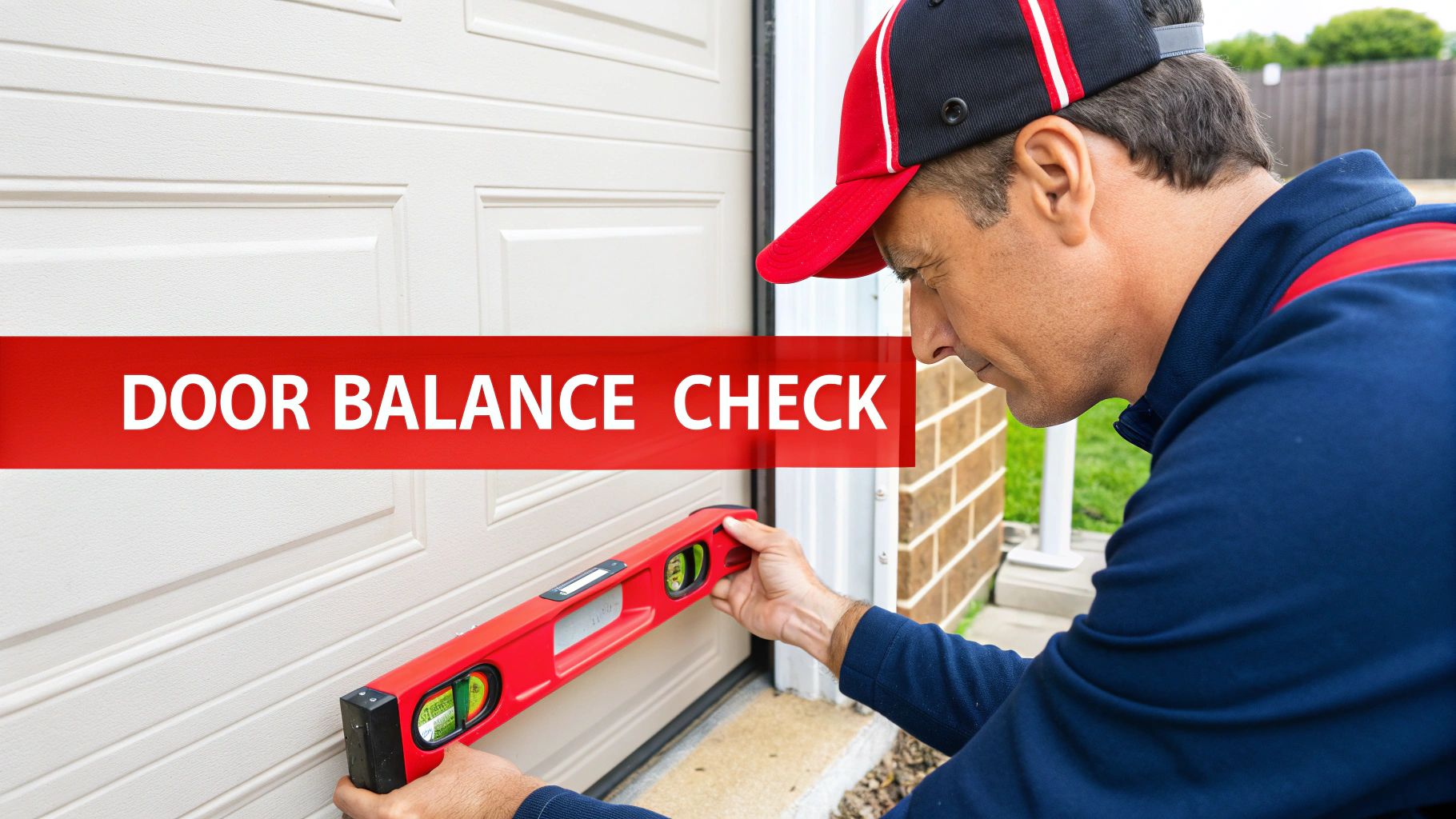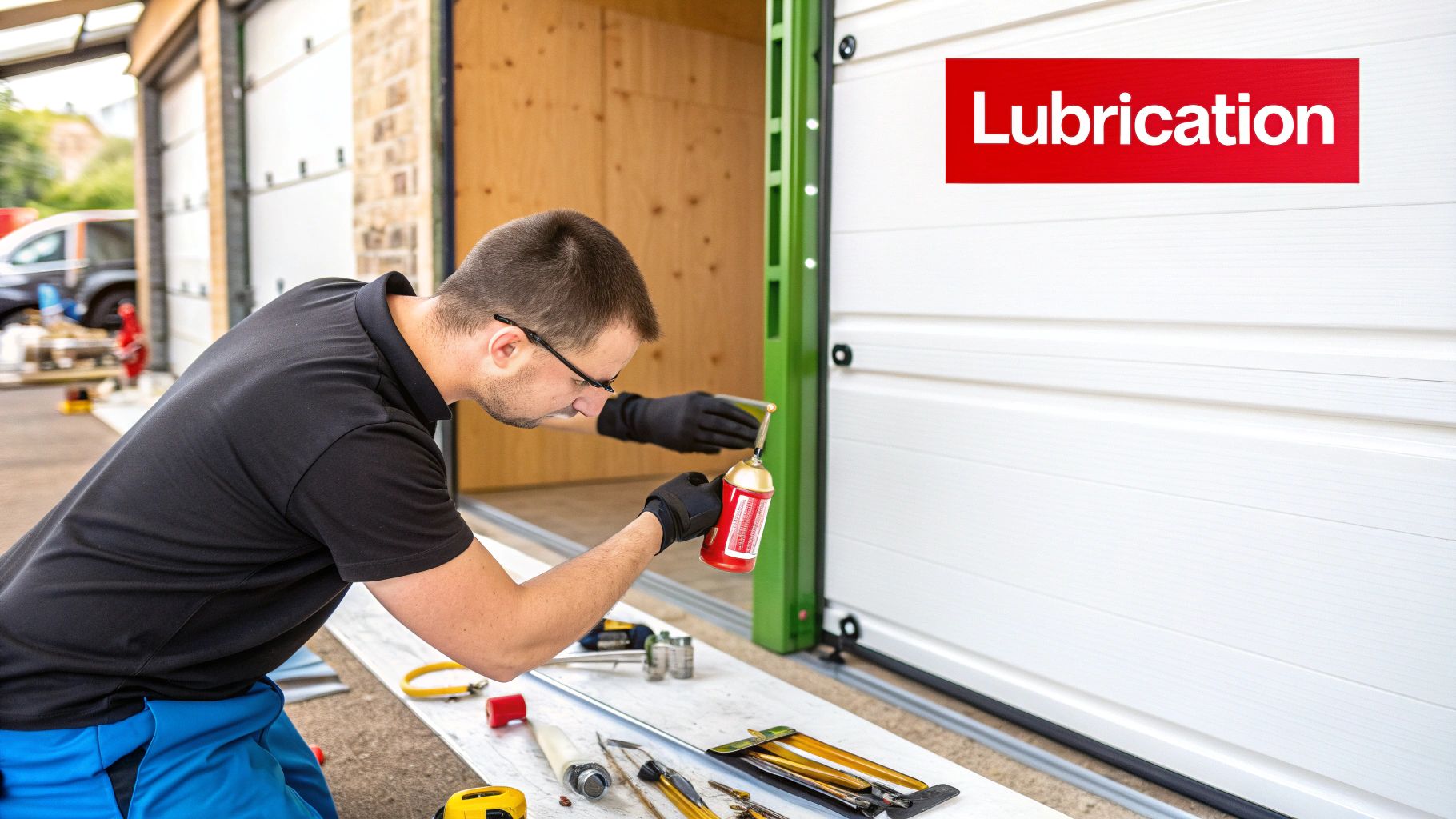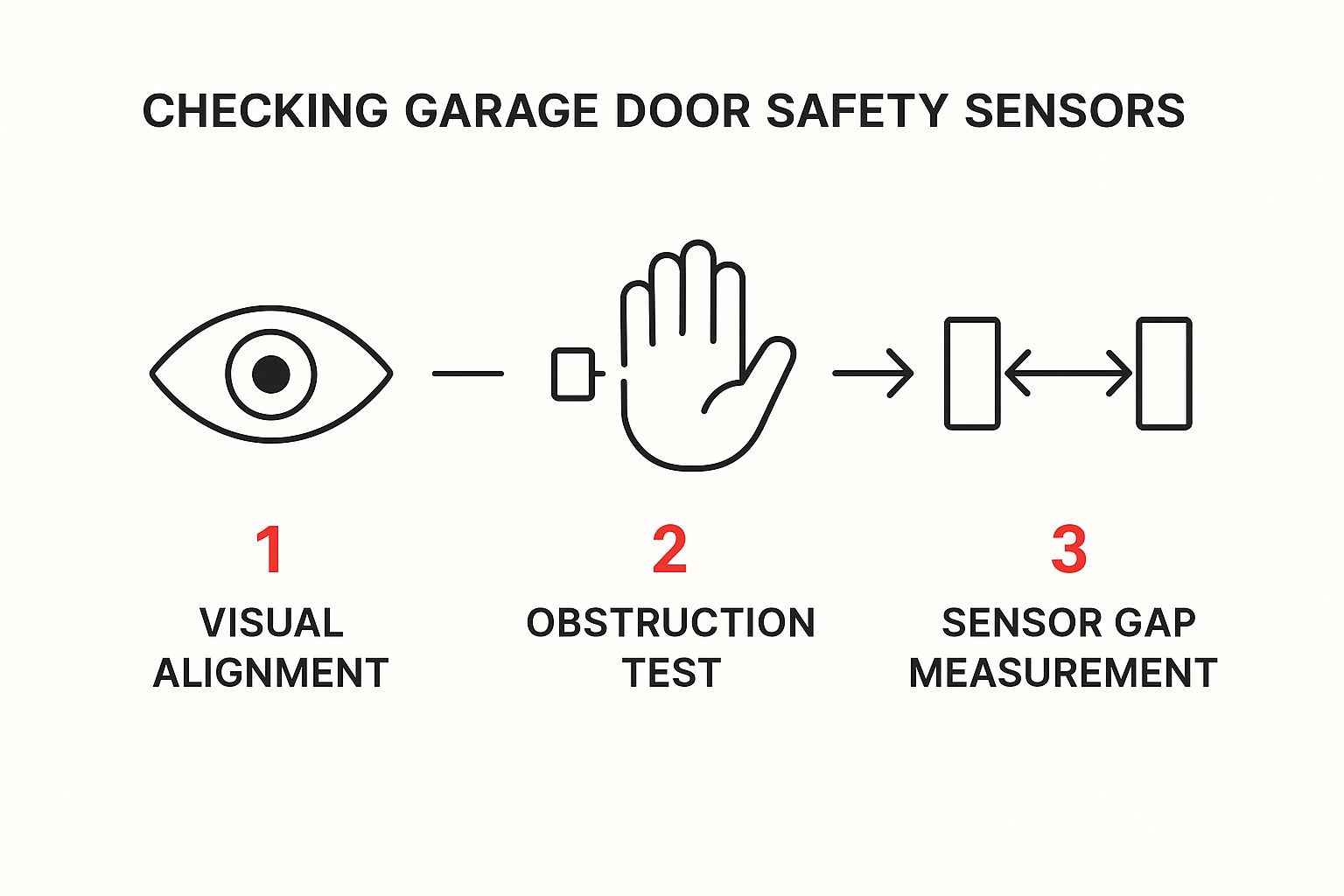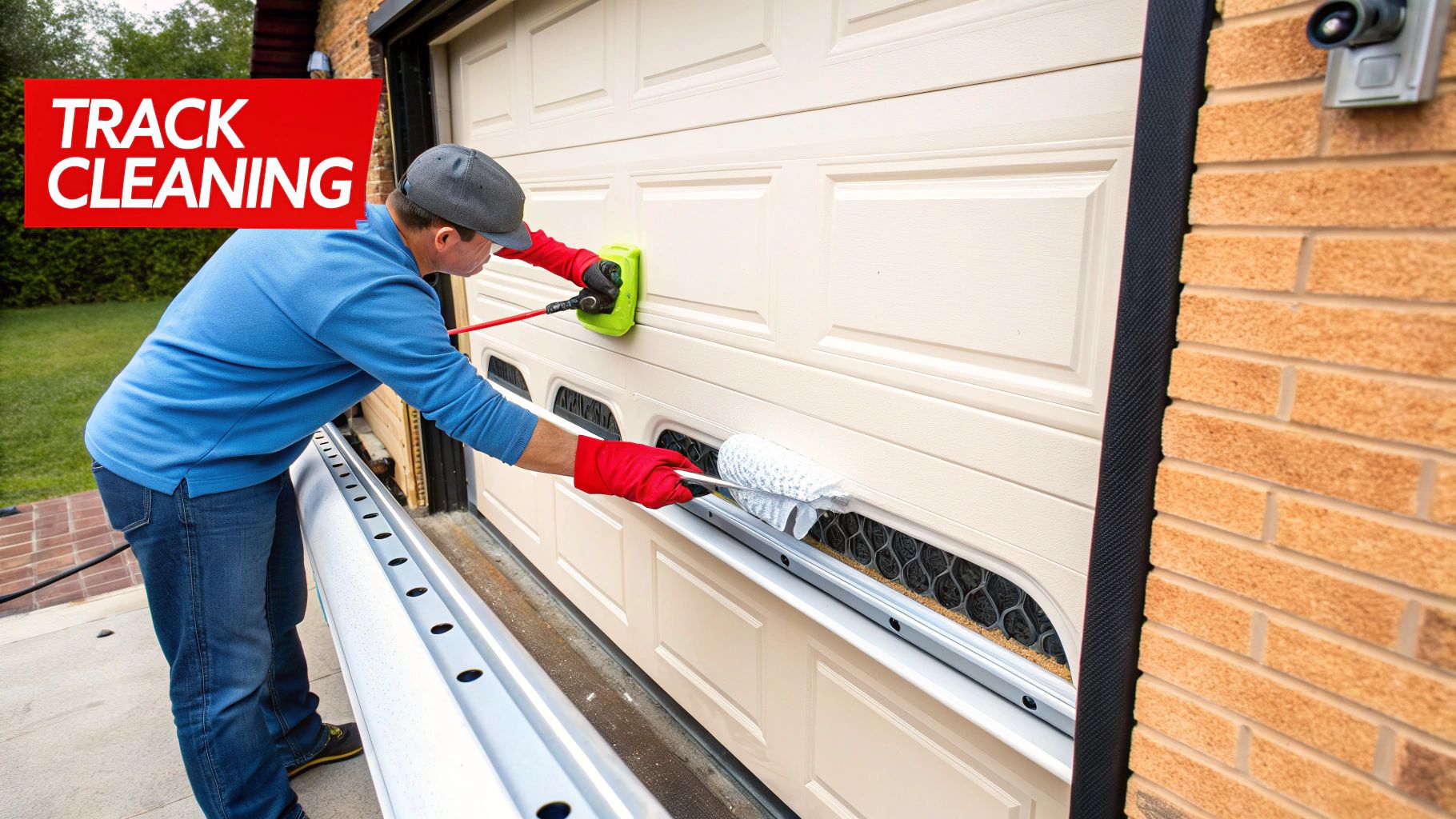Your garage door is likely the largest moving object in your home or business. You rely on it daily, but when was the last time you gave it a proper inspection? For most property owners, the answer is "not recently enough." Neglecting regular upkeep is more than an inconvenience; it's a significant risk to your safety, security, and budget. A comprehensive garage door maintenance checklist is your most effective strategy for preventing costly emergency repairs and ensuring reliable performance, especially when facing the brutal Texas heat and unpredictable Oklahoma weather.
Why You Can't Afford to Ignore Garage Door Maintenance
Your garage door is a heavy-duty system expected to perform flawlessly thousands of times a year. When it fails, it's rarely quiet and almost always at the worst possible moment. According to industry data, the average garage door spring is rated for about 10,000 cycles (open/close), which a typical family can burn through in just 5-7 years. Letting maintenance slide doesn't just create a headache—it opens the door to real risks and costs that are surprisingly easy to avoid.
The extreme weather in Texas and Oklahoma accelerates this wear and tear. Scorching summers can cause lubricants to evaporate and door panels to warp, while severe storms can knock tracks out of alignment. A proactive maintenance plan is specifically designed to counteract these local challenges, ensuring your system is resilient enough to handle the climate, whether it's on a suburban home or one of the many new garage steel buildings across the region.
The Real Cost of "Doing Nothing"
Preventative maintenance isn't an expense—it's an investment in asset protection. Catching a worn roller or a frayed cable during a routine inspection is a minor, low-cost fix. However, letting that same cable fail can lead to a door crashing down, causing catastrophic damage to vehicles, property, or, far worse, people. The emergency service fee for such a disaster will always dwarf the cost of a scheduled professional tune-up.
Key Takeaway: A well-maintained garage door not only saves you from emergency repair bills but also significantly extends the system's lifespan, maximizing your initial investment and even boosting your property's curb appeal and value.
Industry statistics paint a clear picture. The global garage door market is projected to grow from USD 4.78 billion in 2025 to USD 7.16 billion by 2032. A staggering 46.2% of that market is attributed to repair and maintenance services. These figures underscore how critical upkeep is for combating environmental wear and keeping doors operating safely and efficiently.
Safety Checks You Absolutely Cannot Skip
Beyond the financial impact, safety is the primary reason to adhere to a maintenance schedule. A malfunctioning garage door is a serious hazard. For residential properties, it's about protecting children and pets. For a commercial facility, it's about adhering to safety standards and protecting employees and customers.
There are several non-negotiable safety components to check regularly:
- The Auto-Reverse Mechanism: This critical feature, mandated by federal law under UL 325, causes the door to reverse if it contacts an obstruction. It must be tested frequently to ensure it functions correctly.
- Photo-Eye Sensors: These electronic sensors at the base of the door track are the first line of defense against entrapment. They must be kept clean and precisely aligned to detect any obstruction in the door's path.
- Torsion and Extension Springs: These components are under extreme tension and do the heavy lifting. A failing spring can snap with explosive force. This is one area where an annual professional inspection is the only safe approach.
For commercial properties in Texas and Oklahoma, maintaining detailed maintenance logs is a vital part of OSHA compliance. It helps create a safer workplace and mitigates liability. Following a structured garage door maintenance checklist is simply smart risk management that protects your assets and provides peace of mind.

Seasonal Garage Door Maintenance Schedule At-a-Glance
To simplify the process, here is a breakdown of essential tasks by frequency. This serves as a practical guide to keeping your garage door in peak condition throughout the year.
| Task | Frequency | Key Focus Area |
|---|---|---|
| Visual Inspection | Monthly | Check for wear on cables, springs, and rollers. |
| Balance Test | Monthly | Ensure the door opens smoothly without strain. |
| Reverse Mechanism Test | Monthly | Confirm safety features are operational. |
| Lubricate Moving Parts | Quarterly | Apply lubricant to rollers, hinges, and springs. |
| Check and Tighten Hardware | Quarterly | Secure all bolts and brackets. |
| Weatherstripping Check | Annually | Inspect and replace worn seals for efficiency. |
| Professional Tune-Up | Annually | Get an expert check-up on springs and alignment. |
Following this schedule helps you identify and address minor issues before they escalate into major failures, saving you time, money, and stress.
Your Monthly Look and Listen Inspection

The secret to avoiding expensive, after-hours emergency repairs is to catch problems in their infancy. This monthly check is a quick, five-minute diagnostic of your garage door's health. You don't need any special tools—just your eyes and ears. This simple habit is the cornerstone of any effective maintenance plan, allowing you to spot trouble long before it results in a complete system breakdown.
The goal is to establish a baseline for your door's normal operation. Every system has unique sounds and movements. By observing it once a month, you'll immediately recognize when something is amiss, whether it's a new grinding noise or a slight hesitation during operation. This is your first line of defense, especially for properties in Texas and Oklahoma, where drastic weather changes can accelerate wear.
What to Listen For
First, just listen. Stand inside the garage, close the door, and activate the opener. A healthy garage door system operates with a consistent, steady hum as it moves along the tracks.
Be alert for sounds that indicate stress or friction—these are clear signals that components are failing or misaligned.
- Scraping or Grinding: This often points to worn-out rollers that are dragging instead of spinning smoothly. It could also indicate that the tracks are bent and rubbing against the door.
- Popping or Banging: These loud, abrupt noises are serious red flags. They often signal a problem with the torsion springs, which are under immense tension and can be dangerous.
- Squeaking or Squealing: This is typically the easiest issue to diagnose. It’s a cry for lubrication, indicating that metal components like rollers, hinges, or springs are creating friction.
A useful tip for homeowners and facility managers is to record these sounds on your phone. A short video provides a technician with valuable diagnostic information, saving time and helping to pinpoint the problem accurately.
What to Look For
After the listening test, perform a quick visual sweep of the entire system. Stay safely on the ground and never touch high-tension components like springs or cables. Your goal is observation, not hands-on repair.
Start with the door closed, then open it and watch the components move in unison. Look for anything that seems unusual or out of place.
Pro Tip: Keep a maintenance log in a notebook or on your phone. Note the date and any observations, such as "Minor fraying on the left lift cable" or "Door seems to slow down halfway up." This history is invaluable when a professional needs to diagnose a complex, intermittent problem.
Key Visual Checkpoints
Focus your attention on the most critical components—the parts that bear the most load and experience the most wear from daily operation.
1. Springs and Cables
Examine the torsion spring (the large spring mounted above the door). A visible gap in the coils indicates the spring has broken and requires immediate professional replacement. Inspect the lift cables on each side for signs of fraying, rust, or broken strands. Damaged cables can cause the door to become dangerously unbalanced.
2. Rollers and Tracks
Look at the rollers—the small wheels that run inside the metal tracks. Are any of them cracked, chipped, or visibly worn? They should spin freely, not slide. While inspecting them, confirm that the vertical tracks are securely bolted to the wall and show no signs of bending or misalignment.
3. Door Panels and Alignment
With the door closed, step back and check for warped, dented, or sagging panels, which can occur after severe hail or storms. A single damaged panel can throw the entire door off balance. Also, check the gap along the bottom of the door; it should be even across its entire width. An uneven gap is a classic sign of an imbalanced door. If you're concerned a balance issue has affected your sensors, our guide explains how to test garage door sensors safely and effectively.
Identifying one of these issues doesn't mean a catastrophe is imminent. It means your monthly inspection has succeeded. You've caught a problem early, giving you ample time to schedule a professional assessment before it becomes an emergency.
Hands-On Quarterly Safety and Mechanical Checks
While your monthly observations catch obvious issues, the quarterly inspection involves hands-on testing of critical safety and mechanical systems. This is your opportunity to perform the essential upkeep that ensures your door operates smoothly and safely through the demanding weather cycles in Texas and Oklahoma.
Think of it this way: the monthly check is a quick visual inspection. The quarterly check is when you pop the hood to verify fluid levels and tire pressure. It’s a deeper, more functional assessment that prevents minor issues from escalating into major system failures.
Testing the All-Important Auto-Reverse Feature
The single most important safety feature of your garage door is the auto-reverse mechanism. This system is mandated by UL 325 safety standards because it prevents entrapment, which can cause serious injury or death. Testing it is simple, non-negotiable, and a critical safety practice.
Here's the professional method for testing it:
- Place an Obstruction: Lay a standard 2×4 piece of wood flat on the ground in the center of the door's path.
- Initiate Closing: From a safe distance, use your wall control or remote to close the door.
- Observe the Reaction: The moment the bottom of the door makes contact with the 2×4, it must immediately stop its downward motion and reverse to the fully open position.
If the door does not immediately reverse, stop using it and disconnect the opener. This indicates a critical safety failure that requires immediate professional service.
Cleaning and Aligning Photo-Eye Sensors
Ever had a garage door that stubbornly refuses to close? From our field experience, the vast majority of these service calls—some industry estimates suggest over 80%—are caused by dirty or misaligned photo-eye sensors.
These small but vital components project an invisible infrared beam across the garage opening. If anything interrupts that beam, the door will not close. It's a simple yet highly effective safety system that is easily disrupted by dirt or misalignment.
This infographic outlines the simple process for maintaining your photo-eye sensors.

As you can see, proper alignment is just as important as cleanliness.
Here’s how to keep them working perfectly:
- Wipe the Lenses: Dust, cobwebs, and pollen can obstruct the beam. Use a soft, dry cloth to gently clean the lens of each sensor.
- Check Indicator Lights: Each sensor has an indicator light (typically green or red). If a light is blinking or off, the sensors are misaligned.
- Adjust as Needed: Gently reposition the sensor by hand until both indicator lights glow solid, confirming they are correctly aligned.
A Pro's Perspective: For businesses, maintaining these sensors is a core component of workplace safety, helping to prevent accidents and potential OSHA citations. For a more detailed guide, learn more about how to clean garage door tracks and the surrounding areas.
Lubricating Key Mechanical Components
Friction is the primary enemy of any mechanical system. In the high heat of a Texas summer or the damp cold of an Oklahoma winter, proper lubrication is what distinguishes a quiet, reliable door from a noisy, grinding one. This quarterly task reduces wear and tear on the door's hardest-working parts.
Focus your attention on all metal-on-metal contact points.
What to Lubricate:
- Hinges
- Rollers (focus on the stems and bearings, not the nylon wheel itself)
- Torsion spring (a light coat prevents rust and reduces operational noise)
- Bearing plates at each end of the spring bar
What to Use:
Always use a silicone-based or white lithium grease spray specifically formulated for garage doors.
What NOT to Use:
Never use WD-40 for this task. It is a solvent and degreaser, not a long-term lubricant. It can strip away existing grease and attract dust, ultimately making the problem worse.
The Annual Deep Dive for Long-Term Performance
Your monthly and quarterly checks are for spotting immediate issues, but the annual inspection is a comprehensive health assessment for your garage door system. This deep dive is designed to identify and address the slow, silent threats to your door's longevity: metal fatigue, gradual imbalance, and cumulative weather damage.
This is your investment protection plan. By dedicating an hour or two once a year, you can prevent the spectacular failures that often occur on a freezing Oklahoma morning or during a blistering Texas heatwave.
The Critical Door Balance Test
If you perform only one annual task, make it the door balance test. This simple diagnostic reveals the health of your torsion springs, which do the actual heavy lifting. An unbalanced door forces the opener motor to work harder, leading to premature burnout—a costly and entirely preventable repair.
Here's the safe procedure:
- With the door fully closed, pull the red emergency release cord to disconnect the opener.
- Manually lift the door to about halfway open. It should feel relatively light and easy to move.
- Carefully let go of the door.
A properly balanced door will remain in place, drifting no more than a few inches. If it slams shut or flies open, the springs require immediate professional adjustment. Warning: Do not attempt to adjust high-tension springs yourself. This is extremely dangerous and should only be performed by a trained technician.
Securing the System Hardware
A garage door cycles thousands of times annually, and the resulting vibration inevitably loosens hardware. An annual tightening session is your best defense against the system shaking itself apart over time.
With the door closed, use a socket wrench to check and tighten all roller brackets and the bolts securing the tracks to the wall. A loose track can allow rollers to pop out, causing the door to jam or even fall.
A Pro's Tip: A significant percentage of our emergency calls in Texas and Oklahoma are for a door that has come off its tracks. In nearly every case, the root cause is loose hardware. This five-minute check you can perform yourself prevents one of the most common reasons for an emergency service call.
Inspecting the Weatherstripping
The rubber seal at the bottom of your door is a critical barrier against the elements. The intense sun and temperature swings in our region cause this weatherstripping to become brittle, cracked, and ineffective over time.
Inspect the entire bottom seal and the vinyl trim around the door frame. Look for cracks, gaps, or areas where the seal is flattened. A compromised seal allows dirt, water, and pests to enter and significantly reduces your garage's energy efficiency. Replacing worn weatherstripping is a low-cost, high-impact home maintenance task.
Cost of Neglect vs. Proactive Maintenance
Still not convinced this annual check is worthwhile? Let's analyze the numbers. A small investment in proactive care saves you from significant costs and stress down the road.
| Common Issue from Neglect | Average Emergency Repair Cost (TX/OK) | Annual Proactive Maintenance Cost | Potential Savings |
|---|---|---|---|
| Opener Motor Burnout (from imbalance) | $450 – $700 | ~$129 | $321 – $571 |
| Broken Torsion Spring | $350 – $550 | ~$129 | $221 – $421 |
| Door Off-Track (from loose hardware) | $300 – $600 | ~$129 | $171 – $471 |
| Full Door Panel Replacement | $800 – $1,500+ | ~$129 | $671 – $1,371+ |
The data is clear: the cost of a reactive, emergency repair always exceeds the cost of a scheduled professional tune-up. Market analysis shows that while straightforward repairs like spring replacements account for about 40% of service jobs, the most complex and expensive work invariably stems from long-term neglect.
This annual deep dive keeps you ahead of costly failures. Of course, for aging systems, an upgrade is often the smartest long-term solution. Our team can guide you through the latest in durable, modern garage door openers that offer enhanced security and smart features.
Ultimately, this annual inspection is the single most effective action you can take to protect your investment and ensure your door operates safely and reliably every time.
Taking Care of Your Smart Garage Door System
Modern smart garage door openers are integral components of a connected home or business, a trend we see growing rapidly across Texas and Oklahoma. The convenience of remote access and enhanced security also introduces a new set of maintenance requirements focused on software, connectivity, and power.
The rise of the Internet of Things (IoT) has transformed garage door care. The garage door repair market, valued at $2.5 billion in 2023, is projected to reach $4.2 billion by 2032. This growth isn't just from mechanical repairs; it's driven by the need for technical support for smart systems, including software updates and sensor diagnostics.
Firmware Updates and Security
Your smart opener's firmware is its brain. Like a smartphone or computer, it requires regular updates from the manufacturer to fix bugs, add features, and, most importantly, patch security vulnerabilities. An opener with outdated firmware can be a weak point in your property's security.
Checking for updates is simple:
- Open the manufacturer's companion app on your smartphone.
- Navigate to the device settings menu.
- Look for an option like "Firmware Update" or "Check for Updates" and follow the prompts.
A Quick Word on Security: It's an often-overlooked risk, but a 2023 industry report revealed that 45% of IoT devices contain significant security vulnerabilities. An un-updated smart garage door opener could be one of them. I strongly recommend enabling automatic updates if the feature is available.
Wi-Fi Signal and App Performance
A smart opener is useless if it's frequently offline. If your app often fails to connect, the problem is almost always a weak Wi-Fi signal in the garage. This is a common issue, especially in larger homes or commercial buildings with concrete walls that block the signal.
The most effective solution is to install a Wi-Fi range extender or a mesh network node near the garage. This one-time hardware upgrade boosts the signal where it's needed most, resolving most connectivity issues. If you are building out a fully connected property, this guide to the best smart home gadgets offers excellent advice for creating a reliable network.
Battery Backup for Power Outages
From Texas thunderstorms to Oklahoma ice storms, power outages are a reality. A battery backup ensures your smart opener remains functional when the power goes out. Most newer models either include one or offer it as an optional accessory.
Test the battery at least twice a year:
- Unplug the garage door opener from its power outlet.
- Use your remote to open and close the door. It should complete at least one full cycle on battery power.
- Plug the unit back in.
If the door fails to operate, the battery needs to be replaced. A functional backup ensures you are never locked in or out of your garage during an outage. For systems with advanced features, understanding their power requirements is key. Our team can provide specific guidance on overhead garage door sensors and their integration.
Common Garage Door Maintenance Questions

Even with a detailed maintenance checklist, questions are inevitable. Having served homeowners and businesses across Texas and Oklahoma for years, our technicians have encountered nearly every possible scenario. Here are expert answers to some of the most common questions we receive.
Our goal is to empower you to handle minor upkeep, make informed decisions, and recognize when it's time to call a professional.
What’s the Right Lubricant for a Hot Climate?
This is a critical question for our region. In the intense heat of Texas and Oklahoma, you must use a high-quality silicone or white lithium grease spray. These lubricants are engineered to withstand extreme temperatures without thinning, dripping, or evaporating, providing durable protection for moving parts.
Avoid all-purpose products like WD-40 for regular lubrication. While excellent as a solvent for loosening rusted parts, it is not a true, long-lasting lubricant. It can attract dust and grime, creating an abrasive paste that accelerates wear and makes the problem worse.
How Often Should a Commercial Door Be Serviced?
For commercial doors, the service frequency depends entirely on usage. As a baseline, most businesses should schedule a comprehensive professional tune-up and safety inspection at least annually.
However, for high-cycle applications—such as loading docks, automotive service bays, or distribution centers—a semi-annual or even quarterly service plan is recommended. This goes beyond preventing downtime; consistent, documented maintenance is a key component of OSHA compliance and helps ensure a safe working environment for your employees and visitors.
Can I Replace My Own Garage Door Springs?
The answer is an emphatic no. Garage door springs are under extreme tension, storing enough kinetic energy to cause catastrophic property damage, severe injury, or even death if mishandled during removal or installation.
This is a job that must always be left to a trained, insured professional. Technicians have the specialized tools (winding bars), knowledge, and experience to perform the work safely and correctly. If you notice a gap in your torsion spring or the door suddenly becomes extremely heavy to lift manually, call for professional service immediately.
Safety First: Attempting to replace a garage door spring is one of the most dangerous DIY projects a property owner can undertake. The risk of the spring snapping or the door crashing down is exceptionally high. Please prioritize your safety and leave this task to the experts.
Why Does My Door Go Back Up After It Hits the Floor?
This common issue almost always points to the opener’s close-force or travel-limit settings. The opener's logic interprets the contact with the floor as an obstruction and engages the safety reverse feature as designed.
While your owner's manual may provide instructions for minor adjustments, this symptom can also indicate a more serious underlying problem, such as an unbalanced door or misaligned tracks, which increases resistance. If a small adjustment to the settings doesn't resolve the issue, have a professional diagnose the root cause to avoid putting excessive strain on the opener's motor and gears.
When you need reliable answers or professional service from a team that knows garage doors inside and out, trust the experts at Overhead Door Co. of Tex-Oma. For professional maintenance, urgent repairs, or a consultation on a new installation, visit our website to schedule your service today.
